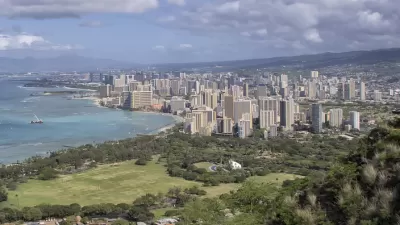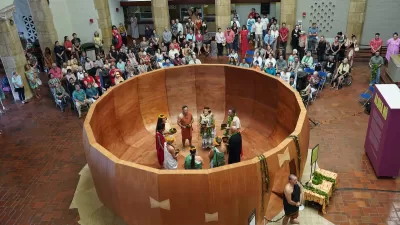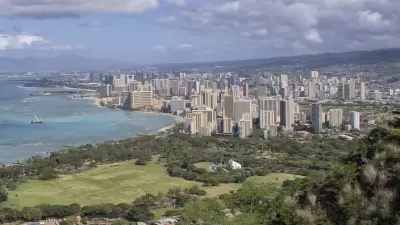Despite its immeasurable geographic and cultural distinctiveness, there is perhaps no American city that has embraced Modernist city planning as fully as Honolulu has.

"The Corbusian connection struck me most acutely when I realized on my recent trip that many of Honolulu’s towers, both in Waikiki and throughout the rest of the city, sit atop open-air lobbies, of the very sort that Corbu said would bring healthy breezes to the masses. I suppose it makes sense in Hawaii, with the trade winds and all, but the effect is still deadening. Ground floors are given to parking areas. Towers are surrounded by pointless greenery and setbacks, making them mutually hostile towards each other. Curb cuts interrupt the sidewalk and, in many neighborhoods, there’s really nowhere to walk to."
"Honolulu should be the most distinctive city in the country. It is literally an island unto itself. In fact, it’s the most isolated big city in the world. I would have thought that a city on an island would embrace efficiency and create dense, lively places in order to conserve scarce land, the way Hong Kong or San Francisco does. Instead, Honolulu looks like Houston with volcanoes."
"Of course, all of these places reflect their historical eras and the prevailing fashions when they were built. That’s another reason I’m sad about Honolulu. It was invaded too soon, before the native culture had a chance to make a lasting architectural impact. It was built too late, without much of an old compact downtown to provide refuge from the auto-oriented, suburban form that just happened to dominate at the very moment that Hawaii became a state and its (non-native) population boomed."
FULL STORY: Reconsidering Paradise: How Honolulu Became a Poster Child for American Autocentric Urbanism

Maui's Vacation Rental Debate Turns Ugly
Verbal attacks, misinformation campaigns and fistfights plague a high-stakes debate to convert thousands of vacation rentals into long-term housing.

Planetizen Federal Action Tracker
A weekly monitor of how Trump’s orders and actions are impacting planners and planning in America.

San Francisco Suspends Traffic Calming Amidst Record Deaths
Citing “a challenging fiscal landscape,” the city will cease the program on the heels of 42 traffic deaths, including 24 pedestrians.

Defunct Pittsburgh Power Plant to Become Residential Tower
A decommissioned steam heat plant will be redeveloped into almost 100 affordable housing units.

Trump Prompts Restructuring of Transportation Research Board in “Unprecedented Overreach”
The TRB has eliminated more than half of its committees including those focused on climate, equity, and cities.

Amtrak Rolls Out New Orleans to Alabama “Mardi Gras” Train
The new service will operate morning and evening departures between Mobile and New Orleans.
Urban Design for Planners 1: Software Tools
This six-course series explores essential urban design concepts using open source software and equips planners with the tools they need to participate fully in the urban design process.
Planning for Universal Design
Learn the tools for implementing Universal Design in planning regulations.
Heyer Gruel & Associates PA
JM Goldson LLC
Custer County Colorado
City of Camden Redevelopment Agency
City of Astoria
Transportation Research & Education Center (TREC) at Portland State University
Jefferson Parish Government
Camden Redevelopment Agency
City of Claremont





























